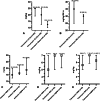International survey of antibiotic dosing and monitoring in adult intensive care units
- PMID: 37331935
- PMCID: PMC10278304
- DOI: 10.1186/s13054-023-04527-1
International survey of antibiotic dosing and monitoring in adult intensive care units
Abstract
Background: In recent years, numerous dosing studies have been conducted to optimize therapeutic antibiotic exposures in patients with serious infections. These studies have led to the inclusion of dose optimization recommendations in international clinical practice guidelines. The last international survey describing dosing, administration and monitoring of commonly prescribed antibiotics for critically ill patients was published in 2015 (ADMIN-ICU 2015). This study aimed to describe the evolution of practice since this time.
Methods: A cross-sectional international survey distributed through professional societies and networks was used to obtain information on practices used in the dosing, administration and monitoring of vancomycin, piperacillin/tazobactam, meropenem and aminoglycosides.
Results: A total of 538 respondents (71% physicians and 29% pharmacists) from 409 hospitals in 45 countries completed the survey. Vancomycin was mostly administered as an intermittent infusion, and loading doses were used by 74% of respondents with 25 mg/kg and 20 mg/kg the most favoured doses for intermittent and continuous infusions, respectively. Piperacillin/tazobactam and meropenem were most frequently administered as an extended infusion (42% and 51%, respectively). Therapeutic drug monitoring was undertaken by 90%, 82%, 43%, and 39% of respondents for vancomycin, aminoglycosides, piperacillin/tazobactam, and meropenem, respectively, and was more frequently performed in high-income countries. Respondents rarely used dosing software to guide therapy in clinical practice and was most frequently used with vancomycin (11%).
Conclusions: We observed numerous changes in practice since the ADMIN-ICU 2015 survey was conducted. Beta-lactams are more commonly administered as extended infusions, and therapeutic drug monitoring use has increased, which align with emerging evidence.
Keywords: Aminoglycosides; Beta-lactams; Drug monitoring; Intensive care units; Vancomycin.
© 2023. Crown.
Conflict of interest statement
The authors declare that they have no competing interests.
Figures


References
-
- Wong G, Briscoe S, McWhinney B, Ally M, Ungerer J, Lipman J, et al. Therapeutic drug monitoring of beta-lactam antibiotics in the critically ill: direct measurement of unbound drug concentrations to achieve appropriate drug exposures. J Antimicrob Chemother. 2018;73(11):3087–3094. doi: 10.1093/jac/dky314. - DOI - PubMed
-
- Blot S, Koulenti D, Akova M, Bassetti M, De Waele JJ, Dimopoulos G, et al. Does contemporary vancomycin dosing achieve therapeutic targets in a heterogeneous clinical cohort of critically ill patients? Data from the multinational DALI study. Crit Care (London, England) 2014;18(3):R99. doi: 10.1186/cc13874. - DOI - PMC - PubMed
MeSH terms
Substances
Grants and funding
LinkOut - more resources
Full Text Sources
Medical

